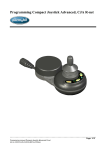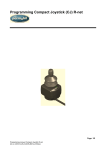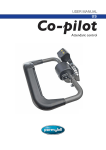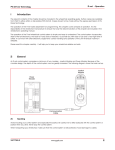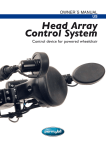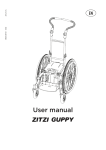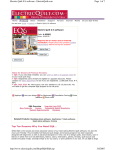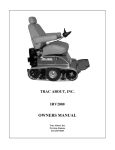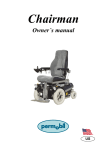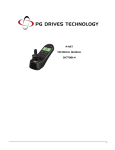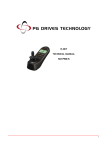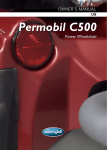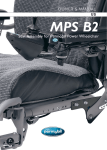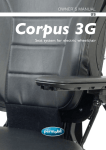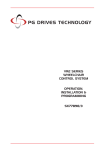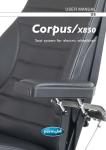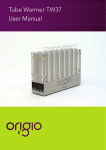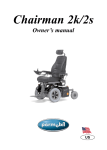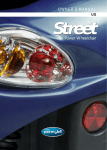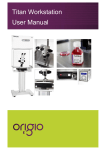Download Compact Joystick Advanced, CJA R-net 1. General
Transcript
Compact Joystick Advanced, CJA R-net Spare part no: 1822772 CJA R-net 1. General The Compact Joystick Advanced R-net (CJA R-net) is an input device and is coupled to the R-net wheelchair electronics. • It’s a proportional joystick module with an adjustable hand pad in a small housing. • The joystick D50800 from PG Drive Technology is used. It is a very reliable contact less joystick which meets the most rigid requirements • The CJA R-net can be adjusted to any individual need and possibility of the user. This can be done by adjusting the ‘Throw’ parameters of the R-net system. • We can install the CJA R-net in a good position through the mounting kit. • Because the CJA R-net has a standard shaft diameter, it will accept adaptive knobs available on the market. • The CJA R-net can be directly connected to the R-net system. • The CJA R-net is completely protected against moisture, which makes it suitable to use outdoors. Page: 1/19 User manual Compact Joystick Advanced R-net Art.no: 205311-US-0, Edition 2. 2009-10 2. Operation 2.1 Introduction The CJA R-net is a joystick module that can directly be connected to the R-net control system of PG Drives Technology (PDGT). So we refer to the R-net Control System Technical Manual – SK77981 – from PGDT. The relevant contents of this chapter should be included in the wheelchair operating guide. Further copies are available from Permobil Inc in either written or disk (Adobe PDF) format. Copies of the SK77981 of PGDT are available from PGDT in either written or disk (Adobe PDF) format. Copies of these 2 documents should not be made without the expressed permission of Permobil Inc or PGDT. The operation of the R-net varies dependent on programming. This chapter covers the special types of operation for the CJA R-net. For a complete description of the system we refer again to the SK77981 of PGDT. It is the responsibility of the wheelchair manufacturer or local dealer to ensure that only the relevant sections of this chapter are included in the wheelchair’s operating manual. Please read this chapter carefully - it will help you to keep your wheelchair reliable and safe. 2.2 General An R-net control system comprises a minimum of two modules - Joystick Module and Power Module. Because of the modular design, the depth of the control system can be greatly increased. The following diagram shows the basic set-up. 2.2.1 Handling Avoid knocking your control system and especially the joystick. Be careful not to strike obstacles with the control system or joystick when you drive. Never drop the control system. When transporting your wheelchair, make sure that the control system is well protected. Avoid damage to cables. Page: 2/19 User manual Compact Joystick Advanced R-net Art.no: 205311-US-0, Edition 2. 2009-10 2.2.2 Operating Conditions Your control system uses industrial-grade components throughout, ensuring reliable operation in a wide range of conditions. However, you will improve the reliability of the control system if you keep exposure to extreme conditions to a minimum. Do not expose your control system or its components to damp for prolonged periods. If the control system becomes contaminated with food or drink clean it off as soon as possible. 2.2.3 Cleaning Clean the control system and the joystick with a cloth dampened with diluted detergent. Be careful when cleaning the joystick. Never use abrasive or spirit-based cleaners. 2.3 Mating Connectors To connect the Communication Cables: Holding the connector housing, firmly push the connector into its mate until you can no longer see the yellow plastic. The connectors are secured using a friction system. To disconnect the Communication Cables: Holding the connector housing firmly, pull the connectors apart. Page: 3/19 User manual Compact Joystick Advanced R-net Art.no: 205311-US-0, Edition 2. 2009-10 2.4 Controls Most of the controls of the CJA R-net are common to the standard joystick module of PGDT. The controls typical for the CJA R-net are explained in this section. For the complete description we refer to the SK77981 of PGDT. Joystick Module Jack Sockets 2.4.1 Joystick The primary function of the joystick is to control the speed and direction of the wheelchair. The further you push the joystick from the centre position the faster the wheelchair will move. When you release the joystick the brakes are automatically applied. If the wheelchair is fitted with actuators, the joystick can also be used to move and select actuators. Refer to programming manual Art.nr: 205314-US-0 for more details and different functionalities of the buttons. 2.4.2 Buttons and Led’s Page: 4/19 User manual Compact Joystick Advanced R-net Art.no: 205311-US-0, Edition 2. 2009-10 2.4.2.1 On/Off Button The On/Off button applies power to the control system electronics, which in turn supply power to the wheelchair’s motors. Do not use the On/Off button to stop the wheelchair unless there is an emergency. (If you do, you may shorten the life of the wheelchair drive components). 2.4.2.2 Left Button Depending on the way the control system has been programmed this key can have different functions. The factory default function is ‘Mode Drive/Axes’. The ‘Mode Drive/Axes’ function allows the user to switch between the drive mode and local axes mode 2.4.2.3 Right Button Depending on the way the control system has been programmed this key can have different functions. The factory default function is ‘Next’. The function ‘Next’ allows the user to select the next profile or the next axis depending in which mode you are at that moment. 2.4.2.4 External On/Off Switch Jack This allows the user to turn the control system on and off using an external device, such as a buddy button. 2.4.2.5 External Profile Switch Jack Depending on the way the control system has been programmed an external connected device, such as a buddy button, can have different functions. The factory default function is ‘Horn’. The horn will sound while the connected switch is pressed – as long as the standard function is selected. 2.4.2.6 Battery/Service Indicator In normal operating state this displays the charge available in the battery and can be used to alert the user to the status of the battery. See CJA State Indication chart. Chapter 3.11 Green Continuous This indicates that all is well. Battery level is >70%. Green Long Flashing This indicates that all is well. Battery level is between 50% and 70%. Green Short Flashing This indicates that all is well. Battery level is between 30% and 50%. Red Continuous The control system is functioning correctly, but you should charge the battery as soon as possible. Battery level is <30%. In addition to the indication of the battery level, the Battery/Service Indicator displays: Alternating Green/Red Flashing The ´slow´ alternating flashing is the reconfiguration, fast flashing is request to shut down and restart the system. (after adding or removing e.g an extra joystick). Red Flashing The system has detected an inhibit. Page: 5/19 User manual Compact Joystick Advanced R-net Art.no: 205311-US-0, Edition 2. 2009-10 Green Pulse with Red Failure Indication The system has detected a failure. Service is required. No Light System is off. 2.4.2.7 Status Indicator This displays the status of the joystick module. Green Continuous This indicates that the joystick is in drive mode. In this mode it is possible to drive and to change profile. Green Flashing This indicates that the joystick is in latched drive mode. In this mode it is possible to drive and to change profile. Red Continuous This indicates that the joystick is in non-driving mode. Depending on the depth of your system you can do various things. Operating your axes is maybe the best known one. Red/Green Fast Flashing This indicates that the joystick is in Drive Axis. Refer to programming manual Art.nr: 205314-US-0 for more details. 2.4.2.8 Led Bar The Led Bar displays extra information about the status of the joystick module. Normal drive or latched mode: Profile 1 Profile 2 Profile 3 Profile 4 Higher Profiles If the speed of the wheelchair is being limited; for example, by a raised seat, then the highest profile–4–LED indicator led will flash. If the wheelchair is prohibit from driving; for example, be a raised seat, the profile indicator will turn off when the joystick is out of neutral. When the joystick is in neutral position, the led’s will show the actual profile. Joystick out of neutral Page: 6/19 User manual Compact Joystick Advanced R-net Art.no: 205311-US-0, Edition 2. 2009-10 Local output mode: The way to operate you actuators, lights or horn depends on how the CJA is programmed. Up to 16 different outputs (e.g. recline, left indicator, horn, etc.) can be programmed. The outputs are located in 4 groups and each group can contains up to 4 outputs. If you enter the local output mode you need first to select a group. The group is indicated by a flashing led. Group 1 Group 2 Group 3 Group 4 After you selected a group you can select the desired output. The output is indicated by a LED. Output 1 Output 2 Output 3 Output 4 If your wheelchair is setup to use only up to 4 outputs in 1 group, the group selection is not needed. 2.5 Diagnostic Screen or Acoustic Feedback When the control system safety circuits have operated and the control system has been prevented from moving the wheelchair, a diagnostics code will be displayed. This indicates a system trip, i.e. the R-net has detected a problem somewhere in the wheelchair’s electrical system. All red LED’s will flash periodically alternated with a green flash of the battery/service indicator. The number of red flashes is an indication of the fault. We refer to the State Indication Chart. Se Chapter 3.11 in this manual If the error is not critical, for example the ICS (Intelligent Control System) detects a broken light, then drive will still be possible, however, an acoustic signal will be produced intermittently. Page: 7/19 User manual Compact Joystick Advanced R-net Art.no: 205311-US-0, Edition 2. 2009-10 2.6 Getting Ready to Drive - Operate the on/off switch. The Battery/Service indicator and the Led Bar will go through an initializing process then show the base indications as follows. - Check that you select a profile which suits you. - Push the joystick to control the speed and direction of the wheelchair. Remark! If you push the joystick before or just after you switch the control system on, the Led Bar will not illuminate and the joystick will bleep. You must release and centre the joystick to resume normal operation. 2.7 Tips for Using your Control System 2.7.1 Driving - General Make sure that the control system is mounted securely and that the joystick position is correct. The hand or limb you use to operate the joystick should be supported, for example by the joystick modules arm pad. Do not use the joystick as the sole support for your hand or limb - wheelchair movements and bumps could upset your control. 2.7.2 Driving Technique The control system interprets your joystick movements and produces appropriate movements of your wheelchair. You will need very little concentration to control the wheelchair, which is especially useful if you are inexperienced. One popular technique is to simply point the joystick in the direction you want to go. The wheelchair will “home-in” on the direction you push the joystick. The further you push the joystick away from the rest position, the faster the wheelchair will go. Releasing the joystick will stop the wheelchair. The intelligent speed control system minimizes the effects of slopes and different types of terrain. Remark! The wheelchair user must be capable of driving a wheelchair safely. Permobil Inc accepts no liability for losses of any kind arising from failure to comply with this condition. 2.7.3 Slow or sluggish movement If the wheelchair does not travel at full speed or does not respond quickly enough, and the battery condition is good, there may be a nonhazardous fault. Contact your service agent. Page: 8/19 User manual Compact Joystick Advanced R-net Art.no: 205311-US-0, Edition 2. 2009-10 2.8 Precautions for Use In the event of the wheelchair moving in an unexpected way RELEASE THE JOYSTICK. This action will stop the wheelchair under any circumstances. 2.8.1 Hazards Do not drive the wheelchair: • Beyond restrictions indicated in your wheelchair user manual, for example maximum inclines, curb height etc. • In places or on surfaces where a loss of wheel grip could be hazardous, for example on wet grassy slopes. • If you know that the control system or other crucial components require repair. Although the R-net control system is designed to be extremely reliable and each unit is rigorously tested during manufacture, the possibility of a system malfunction always exists (however small the probability). Under some conditions of system malfunction the control system must (for safety reasons) stop the chair instantaneously. If there is any possibility of the user falling out of the chair as a result of a sudden braking action, it is imperative that a restraining device such as a seat belt is supplied with the wheelchair and that it is in use at all times when the wheelchair is in motion. Permobil Inc accept no liability for losses of any kind arising from the unexpected stopping of the wheelchair or arising from the improper use of the wheelchair or control system. Do not operate the control system if the chair behaves erratically, or shows abnormal signs of heating, sparks or smoke. Turn the control system off at once and consult your service agent. Permobil Inc accepts no liability for losses of any kind arising from failure to comply with this condition. Electronic equipment can be affected by Electro Magnetic Interference (EMI). Such interference may be generated by radio stations, TV stations, other radio transmitters and cellular phones. If the chair exhibits erratic behaviour due to EMI, turn the control system off immediately and consult your service agent. Permobil Inc accepts no liability for losses of any kind arising from failure to comply with this condition. It is the responsibility of the chair manufacturer to ensure that the wheelchair complies with appropriate National and International EMC legislation. Permobil Inc accepts no liability for losses of any kind arising from failure to comply with this condition. The wheelchair user must comply with all wheelchair safety warnings. Permobil Inc accepts no liability for losses of any kind arising from failure to comply with this condition. Page: 9/19 User manual Compact Joystick Advanced R-net Art.no: 205311-US-0, Edition 2. 2009-10 2.9 Safety Checks The electronic circuits in your control system have been designed to be extremely safe and reliable. The on-board microcomputer carries out safety checks at up to 100 times per second. To supplement this safety monitoring you should carry out the following periodic checks. If the control system fails any of these checks, do not use the wheelchair and contact your service agent. 2.9.1 Daily Checks Joystick: - With the control system switched off, check that the joystick is not bent or damaged and that it returns to the centre when you push and release it. If there is a problem do not continue with the safety checks and contact your service agent. 2.9.2 Weekly Checks Parking brake: - This test should be carried out on a level floor with at least one meter clear space around the wheelchair. - Switch on the control system. - Check that the LEDs remain on, after initialization and that the battery gauge is displaying a reasonable amount of charge. - Push the joystick slowly forwards until you hear the parking brakes operate. The chair may start to move. - Immediately release the joystick. You must be able to hear each parking brake operate within a few seconds. - Repeat the test a further three times, pushing the joystick slowly backwards, left and right. Connectors: - Make sure that all connectors are securely mated. Cables: - Check the condition of all cables and connectors for damage. Joystick gaiter: - Check the thin rubber gaiter or boot, around the base of the joystick shaft, for damage or splitting. Check visually only, do not handle the gaiter. Mounting: - Make sure that all the components of the control system are securely mounted. Do not over tighten any securing screws. 2.9.3 Servicing To ensure continued satisfactory service, we suggest you have your wheelchair and control system inspected by your provider after a period of 1 year from commencement of service. Contact your provider for details when the inspection is due. Page: 10/19 User manual Compact Joystick Advanced R-net Art.no: 205311-US-0, Edition 2. 2009-10 2.10 Programming The control system can be programmed to meet your needs. Programming can be performed using the R-net programmer software and dongle/programming key. If you re-program your control system, make sure that you observe any restrictions given in your wheelchair user manual. Note any changes you make for future reference. Remark! Programming should only be conducted by healthcare professionals with indepth knowledge of PGDT electronic control systems and the CJA R-net. Incorrect programming could result in an unsafe set-up of a wheelchair for a user. Permobil Inc accepts no liability for losses of any kind if the programming of the control system is altered from factory pre-set values. Refer to programming manual Art.nr: 205314-US-0 for more details. 2.11 Servicing All repairs and servicing must be carried out by authorized service personnel. Opening or making any unauthorized adjustments or modifications to the control system or its components will invalidate any warranty and may result in hazards to yourself or other people, and is strictly forbidden. Permobil Inc accepts no liability for losses of any kind arising from unauthorized opening, adjustment or modifications to the R-net control system. If the control system is damaged in any way, or if internal damage may have occurred through impact or dropping, have the product checked by qualified personnel before operating. Permobil Inc accepts no liability for losses of any kind arising from failure to comply with this condition. 2.12 Warranty The CJA R-net is covered by a warranty period defined by the service agent. For details of the warranty period, please contact your service agent. The warranty will be void if the CJA R-net has: - Not been used in accordance with the CJA R-net user manual – this manual – of Permobil Inc. - Not been used in accordance with the R-net control system Technical Manual, SK77981, of PGDT. - Been subject to misuse or abuse. - Been modified or repaired by non-authorized persons. Page: 11/19 User manual Compact Joystick Advanced R-net Art.no: 205311-US-0, Edition 2. 2009-10 3. Installation 3.1 R-net Operation Study Chapter 2. It is important that the operation information in Chapter 2 is supplied, either as part of the wheelchair user handbook or as a separate document. 3.2 Program Settings It is the wheelchair manufacturer’s or dealer responsibility to program the control system to suit the vehicle model and ensure safe operation in compliance with relevant legal requirements over the whole of the operating range. Permobil Inc accepts no liability for losses of any kind due to failure to, or incorrect programming of the R-net Control System. Refer to programming manual Art.nr: 205314-US-0 for more details. Programming should only be conducted by healthcare professionals with in-depth knowledge of PGDT electronic control systems and of the CJA R-net of Permobil Inc, incorrect programming could result in an unsafe setup of a wheelchair for the user. 3.3 Connections The following is a selection of the most common configurations 3.3.1 Control Configurations 3.3.1.1 Basic Configuration Consists of a Power Module, a Communication Cable and a Joystick Module. Page: 12/19 User manual Compact Joystick Advanced R-net Art.no: 205311-US-0, Edition 2. 2009-10 3.3.1.2 Joystick & ICS (Intelligent Control System) Configuration This consists of a Power Module, an Intelligent Seating/Lighting Module (ICS), 3 Communication Cables, R-net connection block and a Joystick Module. Power Module Intelligent Control System (ICS) Joystick Module 3.4 Mounting 3.4.1 Joystick Module Mounting 3.4.1.1 General The Joystick Module should be secured using M4 screws with a maximum penetration of 8mm or M5 screws with a maximum penetration of 10mm. The M4 screws have a pitch circular diameter (PCD) of 32mm. The M5 screws 1-3-5 and 2-4 have a distance between each other of 40mm. 3.4.2 Power Module and ICS Mounting Contact your provider or Permobil Inc if you need further information and advice. 3.4.3 Cables The cables to the different modules must be routed and secured in such a way as to prevent damage to them, for example by cutting or crushing. Contact your provider or Permobil Inc if you need further information and advice. Page: 13/19 User manual Compact Joystick Advanced R-net Art.no: 205311-US-0, Edition 2. 2009-10 3.5 Joystick Module Wiring The Joystick Module is connected to the Power Module with a Communication Cable. To connect the Communication Cables: - Holding the connector housing, firmly push the connector into its mate until you can no longer see the yellow plastic. The connectors are secured using a friction system. To disconnect the Communication Cables: - Holding the connector housing firmly, pull the connectors apart. 3.6 Power Module & ICS Wiring Contact your provider or Permobil Inc. if you need further information and advice. 3.7 Programming Connection 3.7.1 PC Programming To utilize the R-net PC Programming Suite the R-net Dongle must first be connected in the communications system as shown. A USB cable can then be connected between the Dongle and a PC with the R-Net PC Programmer installed. Refer to programming manual Art.nr: 205314-US-0 for more details. Page: 14/19 User manual Compact Joystick Advanced R-net Art.no: 205311-US-0, Edition 2. 2009-10 3.8 Functionality Tests Perform the following tests, in order, on each wheelchair before dispatch. These tests should be conducted in an open space and a restraining device such as a seat belt should always be used. Permobil Inc accepts no liability for losses of any kind arising from failure to comply with this condition. 3.8.1 Joystick and Gaiter - Check that the joystick is not bent or damaged. - Check the thin rubber gaiter or boot, around the base of the joystick shaft, for damage or splitting. Check visually only, do not handle the gaiter. - Check that the joystick returns to the centre position when you push and release it. 3.8.2 Operational Test This test should be carried out on a level floor with at least one meter clear space around the wheelchair. - Switch on the control system. - Check that the battery gauge remains on, or flashes, after one second. - Push the joystick slowly forwards until you hear the parking brakes operate. The chair may start to move. - Immediately release the joystick. You must be able to hear each parking brake operate within a few seconds. - Repeat the test a further three times, pushing the joystick slowly backwards, left and right. 3.8.3 Test Drive - Drive the wheelchair and make sure that it operates correctly for all positions of the user controls. 3.8.4 Soft-Stop Test - Drive the wheelchair at full forward speed and switch the control system off. - The wheelchair must not stop suddenly, but should decelerate to standstill. 3.9 Electromagnetic Compatibility (E.M.C.) The CJA R-net has been tested on a generic wheelchair for compliance with EC directive 89/336/EEC, and the EMC requirements of EN12184. 3.10 Battery Gauge Refer to Chapter 2 for how to read the battery gauge. The battery gauge becomes red when the battery voltage falls below 23.3V whilst the wheelchair is driving on a level surface. Page: 15/19 User manual Compact Joystick Advanced R-net Art.no: 205311-US-0, Edition 2. 2009-10 3.11 State Indication Chart CJA R-net Page: 16/19 User manual Compact Joystick Advanced R-net Art.no: 205311-US-0, Edition 2. 2009-10 Table of Content: Compact Joystick Advanced, CJA R-net .............................................................................1 1. General ............................................................................................................................1 2. Operation .........................................................................................................................2 2.1 Introduction ................................................................................................................2 2.2 General ......................................................................................................................2 2.2.1 Handling...............................................................................................................2 2.2.2 Operating Conditions ...........................................................................................3 2.2.3 Cleaning...............................................................................................................3 2.3 Mating Connectors .....................................................................................................3 2.4 Controls......................................................................................................................4 2.4.1 Joystick................................................................................................................4 2.4.2 Buttons and Led’s ................................................................................................4 2.4.2.1 On/Off Button ................................................................................................5 2.4.2.2 Left Button.....................................................................................................5 2.4.2.3 Right Button ..................................................................................................5 2.4.2.4 External On/Off Switch Jack..........................................................................5 2.4.2.5 External Profile Switch Jack..........................................................................5 2.4.2.6 Battery/Service Indicator ...............................................................................5 Green Continuous..............................................................................................................5 Green Long Flashing .........................................................................................................5 Green Short Flashing ........................................................................................................5 Red Continuous .................................................................................................................5 Alternating Green/Red Flashing .......................................................................................5 Red Flashing ......................................................................................................................5 The system has detected an inhibit......................................................................................5 Green Pulse with Red Failure Indication .........................................................................6 No Light ..............................................................................................................................6 System is off. .......................................................................................................................6 2.4.2.7 Status Indicator .............................................................................................6 Green Continuous..............................................................................................................6 Green Flashing...................................................................................................................6 Red Continuous .................................................................................................................6 Red/Green Fast Flashing...................................................................................................6 2.4.2.8 Led Bar..........................................................................................................6 Normal drive or latched mode: .........................................................................................6 2.5 Diagnostic Screen or Acoustic Feedback...................................................................7 2.6 Getting Ready to Drive ...............................................................................................8 2.7 Tips for Using your Control System............................................................................8 2.7.1 Driving - General..................................................................................................8 2.7.2 Driving Technique................................................................................................8 2.7.3 Slow or sluggish movement .................................................................................8 2.8 Precautions for Use....................................................................................................9 2.8.1 Hazards ...............................................................................................................9 2.9 Safety Checks ..........................................................................................................10 2.9.1 Daily Checks......................................................................................................10 2.9.2 Weekly Checks..................................................................................................10 2.9.3 Servicing............................................................................................................10 Page: 17/19 User manual Compact Joystick Advanced R-net Art.no: 205311-US-0, Edition 2. 2009-10 2.10 Programming..........................................................................................................11 2.11 Servicing ................................................................................................................11 2.12 Warranty.................................................................................................................11 3. Installation......................................................................................................................12 3.1 R-net Operation........................................................................................................12 3.2 Program Settings......................................................................................................12 3.3 Connections .............................................................................................................12 3.3.1 Control Configurations .......................................................................................12 3.3.1.1 Basic Configuration .....................................................................................12 3.3.1.2 Joystick & ICS (Intelligent Control System) Configuration...........................13 3.4 Mounting ..................................................................................................................13 3.4.1 Joystick Module Mounting..................................................................................13 3.4.1.1 General .......................................................................................................13 3.4.2 Power Module and ICS Mounting ......................................................................13 3.4.3 Cables ...............................................................................................................13 3.5 Joystick Module Wiring.............................................................................................14 3.6 Power Module & ICS Wiring....................................................................................14 3.7 Programming Connection.........................................................................................14 3.8 Functionality Tests ...................................................................................................15 3.8.1 Joystick and Gaiter ............................................................................................15 3.8.2 Operational Test ................................................................................................15 3.8.3 Test Drive ..........................................................................................................15 3.8.4 Soft-Stop Test....................................................................................................15 3.9 Electromagnetic Compatibility (E.M.C.)....................................................................15 3.10 Battery Gauge ........................................................................................................15 3.11 State Indication Chart CJA R-net ...........................................................................16 Page: 18/19 User manual Compact Joystick Advanced R-net Art.no: 205311-US-0, Edition 2. 2009-10 HEADOFFICE Permobil AB BOX 120 Per Uddéns väg 20 SE-861 23 Timrå Tel +46 60 59 59 00 Fax +46 60 57 52 50 [email protected] FRANCE Permobil sarl 225, rue Tourmaline Pôle d’Activités Nord FR-13510 Eguilles Tel +33 4 42 52 80 30 Fax +33 4 42 52 80 31 [email protected] PERMOBIL EUROPE BV De Doom 22 NL-6419 CX Heerlen Tel +31(0) 45 564 54 90 Fax +31(0) 45 564 5491 [email protected] GREECE Scan Ideal S.A. 28 Tzavela str GR-54249 Thessaloniki Tel +30 231 0320 150 Fax +30 231 0320 151 [email protected] BELGIEN Permobil Benelux BV Beitel 11 NL-6466GZ Kerkrade Tel +31(0) 45 564 54 80 Fax +31(0) 45 564 54 81 [email protected] HONGKONG 3-Med Medical Instruments Co., Ltd. 26 D, Kin Ga Ind. Building no 9 San On St. Tuen Mun, N.T. Tel +852 2458 3648 Fax +852 2424 6541 [email protected] AUSTRALIA Northcott Dynamic Living Designs No. 1 Fennell Street North Parramatta NSW, 2151 Australië Tel +61 2 9890 0100 Fax +61 2 9683 2827 [email protected] ICELAND Stod Hf Trönuhrauni 8 IS-220 Hafnarfirdi Tel +354 565 28 85 Fax +354 565 14 23 DENMARK Permobil AS Måløv Tel +45 44 68 14 06 Fax +45 44 68 24 06 [email protected] IRAN Iran Majin Co. Ltd No 114, W. Kayhan St. 15776 Tehran Tel +98 21 875 8583 Fax +98 21 875 8584 GERMANY Permobil GmbH Freie Vogel Strasse 393 DE- 44269 Dortmund Tel+ 49 231 945363 0 Fax +49 231 945363 70 [email protected] ITALY Permobil Italy Via Tartini 5/D I-50144 Firenze Tel +39 055 36 05 62 Fax +39 055 324 60 59 [email protected] JAPAN Permobil K.K. Akasaka wing bld 1F Minato-Wad Akasaka 6-6-15 107-0052 Tokyo Japan Tel +81 3 5603678 Fax+81 3 5603679 NORWAY Permobil AS Hvamsvingen 22 NO-2013 Skjetten Tel. +47 48 12 90 00 Fax +47 63 84 48 50 [email protected] AUSTRIA Permobil GmbH Flüelistraße 10 CH-6064 Kerns Tel +41 41 662 06 00 Fax +41 41 662 06 02 PORTUGAL Mobilitec, Lda Rua dos Verdes, 123 Pedras Rubras PT-4470-6578 MoreiraMaia Tel +351 22 943 61 30 Fax +351 22 943 61 39 [email protected] TURKEY Hakemannltd . Sti. Abdulah Cevdet Sk. 39/7-8 TR-06550Çankaya Ankara Tel +90 312 440 06 32 Fax +90 312 439 96 91 UK Permobil Ltd. Unit 4, West Vale Building Wakefield Rd GB-Brighouse HD6 1PE Tel +44 1484 722 888 Fax+44 1484 723 013 [email protected] USA Permobil Inc 6961 Eastgate Blvd US-37090 Lebanon TN Tel +1 800 736 0925 Fax +1 800 231 3256 [email protected] SOUTH-KOREA ATN Corporation 1006, Yongsan Jun Ja B/D 16-58 Hankagro–3Ka Yongsan-Ku Seoel Tel +82 2 714 8030 Fax +82 2704 8030 Atncorpnetsgo.com SWEDEN Permobil Försäljning & SPAIN Service AB Mobilitec, Lda Box 120 Rua dos Verdes, 123 Per Uddéns väg 20 Pedras Rubras SE-861 23 Timrå PT-4470-658 Moreira- Tel +46 60 59 59 00 Maia Fax +46 60 57 52 50 Tel +351 22 943 61 30 Fax +351 22 943 61 39 SWITSERLAND [email protected] Permobil AG Flüelistraße 10 CH-6064 kerns Tel +41 41 662 06 00 Fax +41 41 662 06 02 [email protected] FINLAND Algol Pharma Ab Pharmaceutical Division 13 P.O. Box Karapellontie 6 FI-02611 Espoo Tel +358 9 509 91 Fax +358 9 509 92 58 Page: 19/19 User manual Compact Joystick Advanced R-net Art.no: 205311-US-0, Edition 2. 2009-10



















